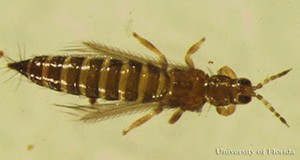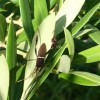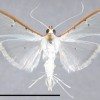 Tiny insects called thrips are difficult to see with the unaided eye but cause very obvious and sometimes ruinous damage to the flowers, buds, and fruit of many important crops. This two-page guide asks and answers the key thrips questions that allow growers to distinguish between chilli thrips, common blossom thrips, and Western flower thrips to more effectively battle against these destructive pests. What does it look like? What is its life cycle? Where is it found? What type of damage does it cause? And, most importantly, who are its natural enemies? Use this guide to help you identify thrips so that you can take effective steps to control them and limit the damage they cause. Written by Nicole Casuso and Hugh Smith with photos by Lyle Buss, Jeff Cluever, Vivek Kumar, P.M.J. Ramakers, Gary Vallad, and Hugh Smith. Published by the Entomology and Nematology Department, UF/IFAS Extension.
Tiny insects called thrips are difficult to see with the unaided eye but cause very obvious and sometimes ruinous damage to the flowers, buds, and fruit of many important crops. This two-page guide asks and answers the key thrips questions that allow growers to distinguish between chilli thrips, common blossom thrips, and Western flower thrips to more effectively battle against these destructive pests. What does it look like? What is its life cycle? Where is it found? What type of damage does it cause? And, most importantly, who are its natural enemies? Use this guide to help you identify thrips so that you can take effective steps to control them and limit the damage they cause. Written by Nicole Casuso and Hugh Smith with photos by Lyle Buss, Jeff Cluever, Vivek Kumar, P.M.J. Ramakers, Gary Vallad, and Hugh Smith. Published by the Entomology and Nematology Department, UF/IFAS Extension.
http://edis.ifas.ufl.edu/in1058
Tag: Lyle Buss
Plagas y Hongos Identificados en Olivos (Olea europea) en Florida
 La producción de olivo o aceitunas (Olea europea) en Florida ha aumentado en los últimos años. La disponibilidad de árboles en los viveros de plantas ha aumentado y muchos residentes los compran para plantarlos en su patio. Afortunadamente, los olivos son una especie relativamente resistente a muchas plagas, pero en ocasiones surgen invasores que pueden causar daños significativos. Algunos patógenos también pueden infectar los olivos y causar enfermedades, reducir los rendimientos o arruinar la apariencia estética de los árboles. Siguiendo las prácticas de cultivo apropiadas para olivos podemos reducir las probabilidades de perder árboles por plagas y enfermedades. Una encuesta realizada con productores de aceitunas en Florida durante el año 2014 identificó las plagas y enfermedades descritas en este documento.
La producción de olivo o aceitunas (Olea europea) en Florida ha aumentado en los últimos años. La disponibilidad de árboles en los viveros de plantas ha aumentado y muchos residentes los compran para plantarlos en su patio. Afortunadamente, los olivos son una especie relativamente resistente a muchas plagas, pero en ocasiones surgen invasores que pueden causar daños significativos. Algunos patógenos también pueden infectar los olivos y causar enfermedades, reducir los rendimientos o arruinar la apariencia estética de los árboles. Siguiendo las prácticas de cultivo apropiadas para olivos podemos reducir las probabilidades de perder árboles por plagas y enfermedades. Una encuesta realizada con productores de aceitunas en Florida durante el año 2014 identificó las plagas y enfermedades descritas en este documento.
This 6-page fact sheet was written by Jennifer L. Gillett-Kaufman, Sandra A. Allan, Jonael H. Bosques-Méndez, and Lyle J. Buss; translated into Spanish by Jonael H. Bosques Méndez, and published by the UF Department of Entomology and Nematology, September 2014.
http://edis.ifas.ufl.edu/in1052
Pests and Fungal Organisms Identified on Olives (Olea europaea) in Florida
 Olive production in Florida has increased over the last few years. As trees become available in nurseries many homeowners are planting them in their landscapes. Fortunately, olives are a relatively pest-free species, but some occasional invaders can be a nuisance or cause lasting harm. A few plant pathogens that may infect olives also can lead to a decline in overall plant health, fruit yield, or the visual appearance of plants. Following correct cultural practices when growing olives can reduce your chances of tree loss from pests and diseases. A survey of olive production and interviews with Florida growers in 2014 identified the pests and diseases described in this 5-page fact sheet, written by Jennifer L. Gillett-Kaufman, Sandra A. Allan, Jonael H. Bosques-Mendez, and Lyle J. Buss, and published by the UF Department of Entomology and Nematology, September 2014.
Olive production in Florida has increased over the last few years. As trees become available in nurseries many homeowners are planting them in their landscapes. Fortunately, olives are a relatively pest-free species, but some occasional invaders can be a nuisance or cause lasting harm. A few plant pathogens that may infect olives also can lead to a decline in overall plant health, fruit yield, or the visual appearance of plants. Following correct cultural practices when growing olives can reduce your chances of tree loss from pests and diseases. A survey of olive production and interviews with Florida growers in 2014 identified the pests and diseases described in this 5-page fact sheet, written by Jennifer L. Gillett-Kaufman, Sandra A. Allan, Jonael H. Bosques-Mendez, and Lyle J. Buss, and published by the UF Department of Entomology and Nematology, September 2014.
http://edis.ifas.ufl.edu/in1046
Olive shootworm, Palpita persimilis Munroe (Insecta: Lepidoptera: Crambidae)
 Palpita persimilis Munroe (Lepidoptera: Crambidae) is a defoliator of olives and privet in South America. Examination of specimens submitted to UF-IFAS and FDACS-DPI prompted the discovery that the species has been established in Florida for many years, having been confused with two similar native species. The confusion parallels historical misidentifications in Peru. To date, all vouchered specimens in Florida with host information were found feeding on leaves of Ligustrum japonicum Thunb. (Japanese privet). This 6-page fact sheet was written by James E. Hayden and Lyle J. Buss, and published by the UF Department of Entomology and Nematology, May 2013.
Palpita persimilis Munroe (Lepidoptera: Crambidae) is a defoliator of olives and privet in South America. Examination of specimens submitted to UF-IFAS and FDACS-DPI prompted the discovery that the species has been established in Florida for many years, having been confused with two similar native species. The confusion parallels historical misidentifications in Peru. To date, all vouchered specimens in Florida with host information were found feeding on leaves of Ligustrum japonicum Thunb. (Japanese privet). This 6-page fact sheet was written by James E. Hayden and Lyle J. Buss, and published by the UF Department of Entomology and Nematology, May 2013.
http://edis.ifas.ufl.edu/in995
Widow Spider Parasitoids Philolema latrodecti (Fullaway) (Insecta: Hymenoptera: Eurytomidae) and Baeus latrodecti Dozier (Insecta: Hymenoptera: Platygastridae) (EENY515/IN919)
 There are limited records of pathogens, parasites, and parasitoids known to affect widow spiders. This 4-page fact sheet describes what is known about two parasitoids, and observations from rearing them in the lab. Written by Christopher S. Bibbs and Lyle J. Buss, and published by the UF Department of Entomology and Nematology, January 2012.
There are limited records of pathogens, parasites, and parasitoids known to affect widow spiders. This 4-page fact sheet describes what is known about two parasitoids, and observations from rearing them in the lab. Written by Christopher S. Bibbs and Lyle J. Buss, and published by the UF Department of Entomology and Nematology, January 2012.
http://edis.ifas.ufl.edu/in919
The Insect Community on the Soil Surface (ENY859/IN876)
It’s easy to find and collect insects, related arthropods, and other invertebrates from the soil surface using simple materials that are readily available. This 7-page fact sheet describes several collection methods and introduces common invertebrates that are found on the soil surface in agricultural fields and gardens in Florida. It was written by Harsimran K. Gill, Robert McSorley, and Lyle Buss, and published by the UF Department of Entomology and Nematology, January 2011.
http://edis.ifas.ufl.edu/in876